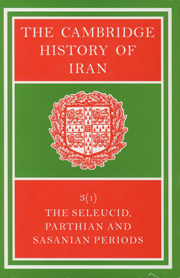Book contents
- Frontmatter
- Introduction
- PART 1 POLITICAL HISTORY
- PART 2 NUMISMATICS
- PART 3 IRANIAN HISTORICAL TRADITION
- PART 4 IRAN AND HER NEIGHBOURS
- 11 Iran and Mesopotamia
- 12 IRAN, ARMENIA AND GEORGIA
- 13 Iran and China
- 14 Cultural Relations between Parthia and Rome
- 15 Byzantium and the Sasanians
- 16 Iran and the Arabs before Islam
- 17 Irano-Turkish Relations in the Late Sasanian Period
- Bibliography
- Plate section
- Plate section
- Plate section
- Map 3. The western regions of the Sasanian empire">
- Map 11. The Silk Road from China to the Roman Orient
- References
13 - Iran and China
from PART 4 - IRAN AND HER NEIGHBOURS
Published online by Cambridge University Press: 28 March 2008
- Frontmatter
- Introduction
- PART 1 POLITICAL HISTORY
- PART 2 NUMISMATICS
- PART 3 IRANIAN HISTORICAL TRADITION
- PART 4 IRAN AND HER NEIGHBOURS
- 11 Iran and Mesopotamia
- 12 IRAN, ARMENIA AND GEORGIA
- 13 Iran and China
- 14 Cultural Relations between Parthia and Rome
- 15 Byzantium and the Sasanians
- 16 Iran and the Arabs before Islam
- 17 Irano-Turkish Relations in the Late Sasanian Period
- Bibliography
- Plate section
- Plate section
- Plate section
- Map 3. The western regions of the Sasanian empire">
- Map 11. The Silk Road from China to the Roman Orient
- References
Summary
In Chinese myth the Tibetan massif and particularly the Kunlun range is taken to be the western limit of the world. The pre-Han lore of the far west is embodied in the story of the miraculous journey of King Mu, of the 10th century B.C., during which he glimpses vast mountains and mysterious kingdoms. Later the Taoists entertained the idea of a western paradise of the immortals, presided over by His-wang-mu, the Queen Mother of the West, and this superstition paved the way for the success of the doctrine of Amitabha Buddha and his western paradise after Buddhism had implanted in China.
The Chinese had no sure knowledge of what lay beyond the western mountains before Chang Ch'ien's exploration in the 2nd century B.C., but archaelogical evidence points to material contacts with western Asia at a much earlier time. For example, from their close similarity a common origin seems probable for the pottery kiln of the Yang-shao neolithic culture of central China and the kiln used at Tepe Sialk in central Iran during the later 4th millennium B.C. The Yang-shao painted pottery itself constitutes the easternmost region reached by a tradition of ceramic ornament which spread from the Iranian plateau. In the case of China this diffusion was not accompanied by the transfer of any cultural system. A comparable slender affinity is seen in the three-lobed and tripod pottery vessels which occur in northern Iran and along the middle course of the Yellow river, the li and ting of the Chinese. In the bronze age on notes an initial divergence of east and west, followed by a peculiar combination of western and eastern traits of material culture.
Keywords
- Type
- Chapter
- Information
- The Cambridge History of Iran , pp. 537 - 558Publisher: Cambridge University PressPrint publication year: 1983
References
- 5
- Cited by



